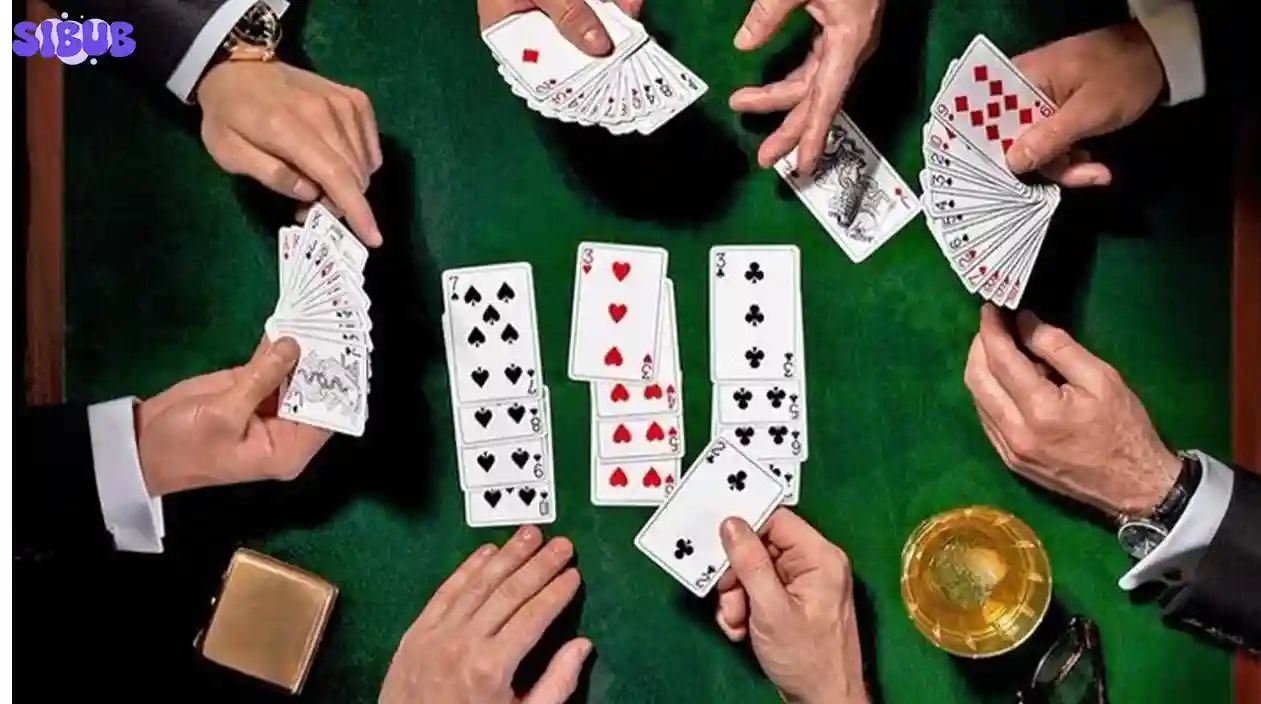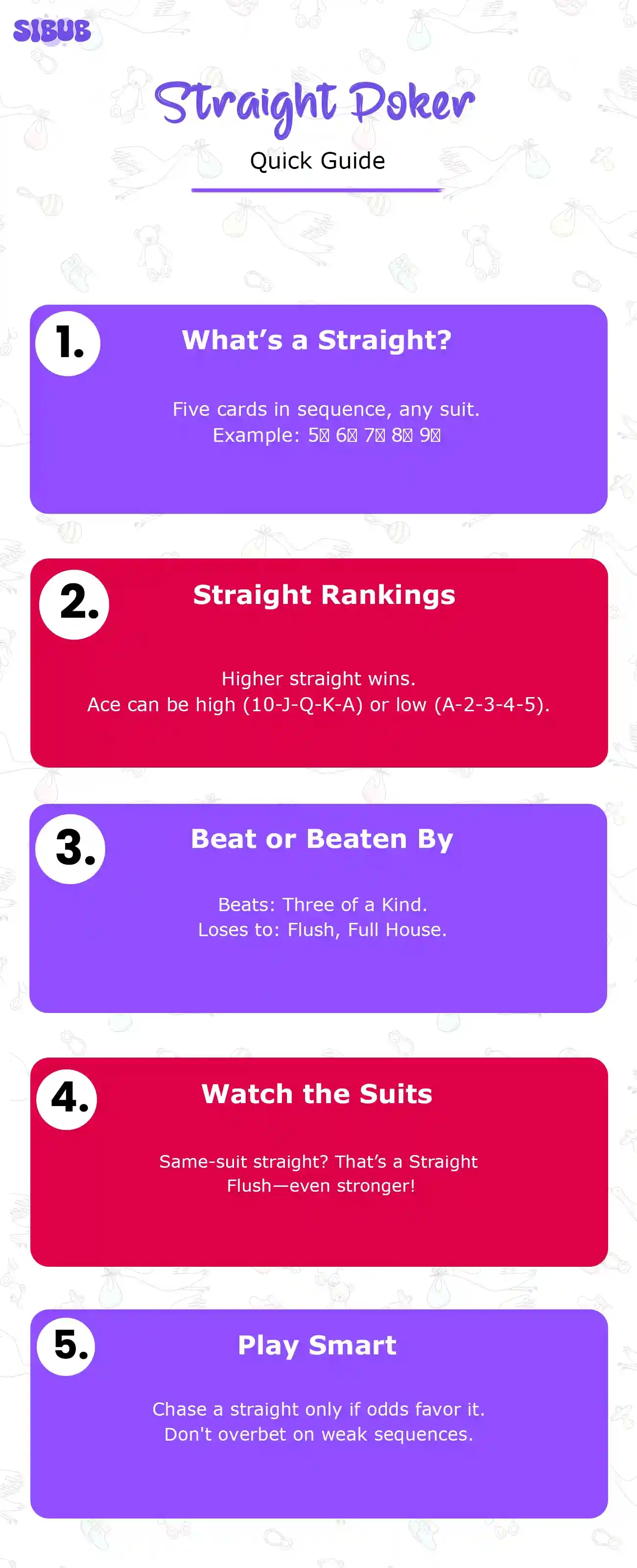If you’re aiming to understand how to play poker, there’s no better starting point than straight poker. This stripped-down variant of the game offers the purest form of poker strategy; there are no community cards, no draws, and no second chances. Just five cards, your wits, and the ability to read people better than they read you.
In this comprehensive guide, we’ll walk you through how to play poker simple, laying out the basic poker rules, the role of bluffing, and exactly what is a straight in poker. You can be sitting at a casual game night or gearing up for a serious home tournament, this is your foundational handbook on straight poker.
What is Straight Poker?
To clarify, what is a straight poker? The term refers to both a particular poker hand ranking and a classic version of the game itself.
In its gameplay context, straight poker is one of the earliest forms of the game. It involves each player being dealt five cards face-down, with no opportunity to exchange them. There’s a single round of betting, followed by a showdown if necessary. Unlike other modern forms like Texas Hold’em or Omaha, there are no community cards or complex draw phases. This makes it both easy to learn and deceptively hard to master.
In terms of hand rankings, a poker straight is a sequence of five consecutive cards in order, such as 4-5-6-7-8, but not all of the same suit.

Visit: Explaining Santa: Is Santa Real and How to Break the News Kindly
How to Play Poker: A Step-by-Step Breakdown
Understanding how to play poker, especially straight poker, comes down to mastering a few essential steps. Let’s walk through them systematically.
1. Set Up the Game
Start with a standard 52-card deck. Jokers may be used depending on your house rules, and when included, they are often treated as wild cards, sometimes referred to as “the bug.”
Number of Players: Anywhere from 2 to 14 players can participate, although 7 to 8 players typically make for the most engaging dynamic.
2. Shuffling and Dealing
- Any player can shuffle the deck; that doesn’t matter. But, it must be cut by the player to the shuffler’s right.
- Each player is given one card, face down, starting with the player seated to the dealer’s left.
Each participant is assigned five cards in a circular fashion.
Following this, there is a singular betting round for the first time.
In straight poker, you are expected to play the hand as dealt; there are no draw rounds or card exchanges, unlike Draw Poker or Seven-Card Stud.
Basic Poker Rules You Need to Know
To navigate how to play poker simple, it’s vital to internalize the basic poker rules:
- The betting occurs within one round. Depending on the situation, players may choose to fold, call, raise, or check their cards.
- The goal in poker is to either bluff or formulate the best-ranked poker hand.
- All players reveal their hands during the showdown, and the player with the best hand, i.e, top cards, becomes the winner. If the rest of the players decide to fold, the last remaining player wins, irrespective of their card’s power.

Discover: 9 Printable Feelings Chart for Kids To Support Emotional Growth
Hand Rankings: What Beats What
When you are aware of what constitutes a strong hand, you can make your game stronger. And also, it is essential to win the game; therefore, when learning how to play poker,you must be knowing this.
Below is a comprehensive look at all the standard poker hands, ranked from highest to lowest:
Five of a Kind (Only with a Wild Card)
Four cards of the same rank plus a Joker. Example: 9-9-9-9-Joker.
Straight Flush
Five cards in sequence, all of the same suit. Example: 6-7-8-9-10 of Spades. This is the best natural hand in the absence of wild cards.
Royal Flush
A specific type of straight flush: A-K-Q-J-10, all in the same suit. This is the highest natural hand possible.
Four of a Kind
Four cards of the same rank, plus one unrelated card. Example: Q-Q-Q-Q-5.
Full House
Three cards of one rank and two of another. Example: K-K-K-2-2. In a tie, the hand with the higher three of a kind wins.
Flush
Five cards of the same suit, not in sequence. Example: A-J-8-4-2 of Hearts. If two players have flushes, the highest card determines the winner.
Straight in Poker
Five cards in numerical order, but from different suits. Example: 3-4-5-6-7. An Ace can be high (A-K-Q-J-10) or low (A-2-3-4-5), but it cannot be both—you cannot wrap around (K-A-2-3-4).
Three of a Kind
Three cards of the same rank, plus two unrelated cards. Example: 7-7-7-K-9.
Two Pair
Two sets of pairs, plus one odd card. Example: 10-10-6-6-8.
One Pair
Two cards of the same rank with three unrelated cards. Example: J-J-4-9-2.
High Card
When no combination is formed, the highest card in the hand plays. This is also used as a tie-breaker for hands of a similar type.

Explore: Top Benefits of Summer Camp for Kids
Strategic Use of Wild Cards
When Jokers are used, they are often designated as wild cards or “the bug.” In this context, the Joker has limited flexibility. It can act as:
- An Ace, or
- The missing card is required to complete a Flush or a Straight.
This allows players to build hands like Five of a Kind, a combination otherwise impossible without wild cards and the highest-ranking poker hand overall.
The Psychology of Bluffing
More than any other element, poker relies on psychology. A weak hand can win against stronger ones through the art of the bluff. This is where the phrase “poker face” becomes significant.
Maintaining emotional neutrality, regardless of your hand, prevents opponents from reading you. Regardless of what you’re holding, a Royal Flush or a worthless hand, your demeanor should not give anything away. A well-timed raise or a confident expression can create doubt; even fear, among your opponents.
Mastering bluffing takes practice, observation, and a deep understanding of human behavior. Over time, you’ll begin to spot hesitation, false bravado, and genuine confidence in your opponents.
How to Play Poker Simple Yet Smart: Winning Techniques
Though straight poker seems simple, there are ways to elevate your game through calculated strategy and situational awareness.
1. Memorize the Hand Rankings
You must know what hand you’re aiming for to make smart betting decisions. Hand strength guides everything in poker.
2. Observe Opponents
Notice patterns. Does someone only bet aggressively with strong hands? Are they bluffing often? Observation pays off.
3. Use Position Wisely
Acting last in the betting round gives you more information and can help guide your actions.
4. Embrace the Bluff
Don’t wait for the perfect hand. Learn to represent strength even when you don’t have it.
5. Play Often and Reflect
Experience is the greatest teacher. Review your hands and think about what you could’ve done differently.
Final Thoughts
Learning how to play poker doesn’t need to be overwhelming. In fact, mastering straight poker offers a solid foundation in the art of the game. You’ll learn to calculate risk, read opponents, and develop a sharp poker face.
No matter, if you play casually or hope to level up into more complex variants, straight poker is the blueprint. It focuses on fundamental skills, not flashy gimmicks, and teaches you how to win with nothing but your cards and confidence.
Now that you understand the basic poker rules, the nuances of a straight in poker, and how to bluff effectively, there’s nothing stopping you from hosting your first game.
So gather your friends, shuffle the deck, and start dealing. The path to becoming a poker master starts here, with one straight hand at a time.
